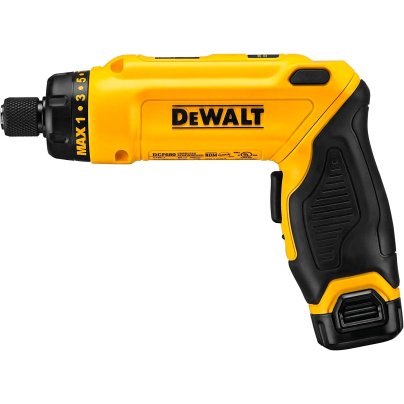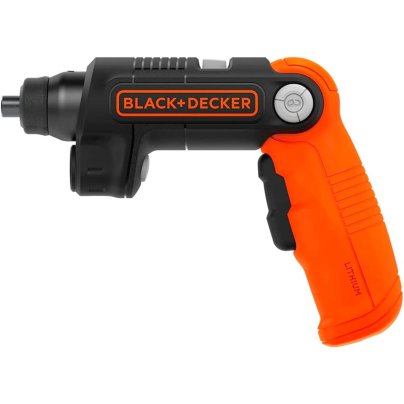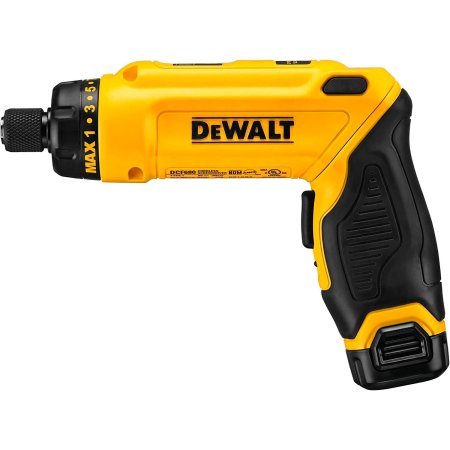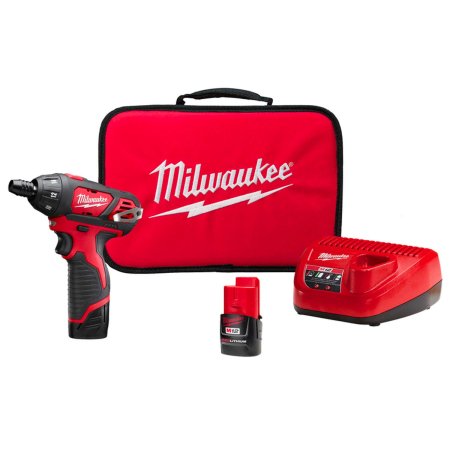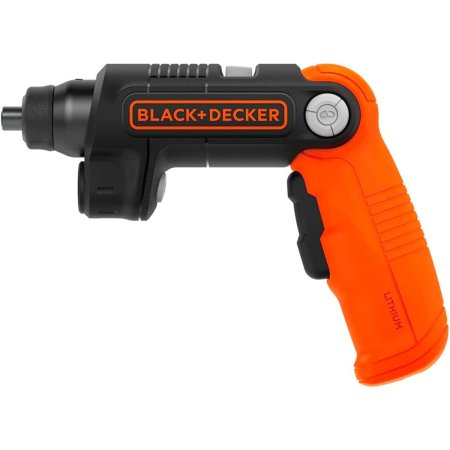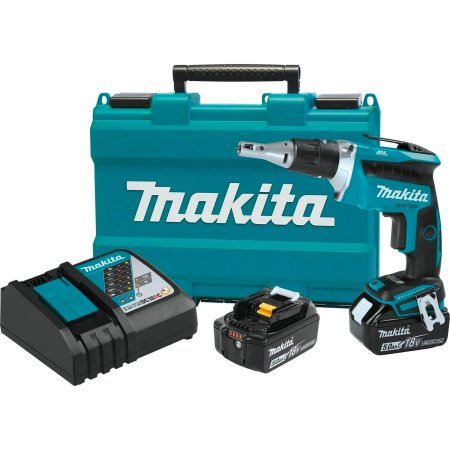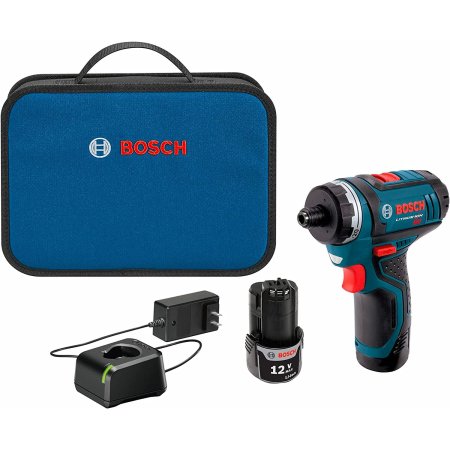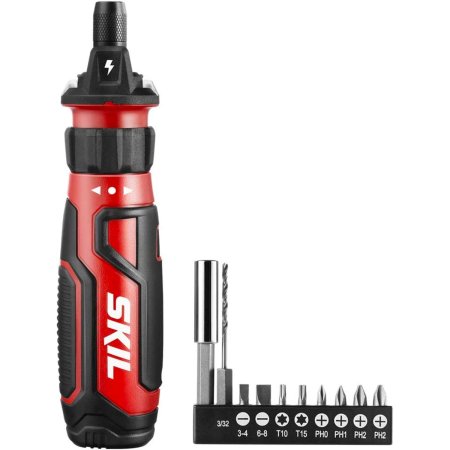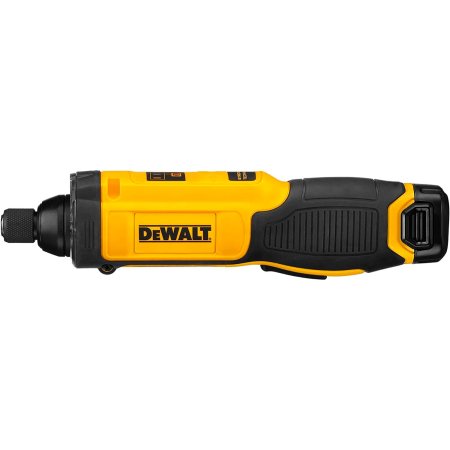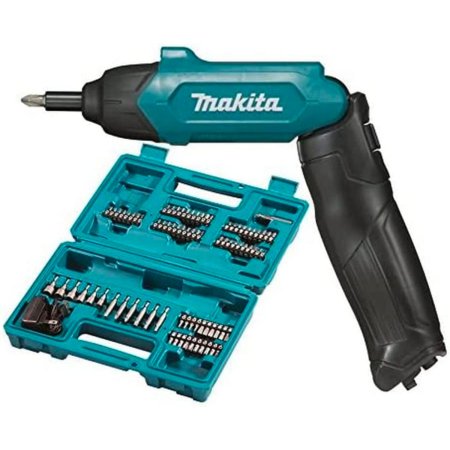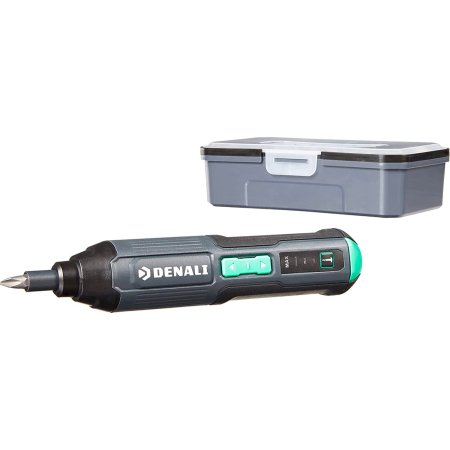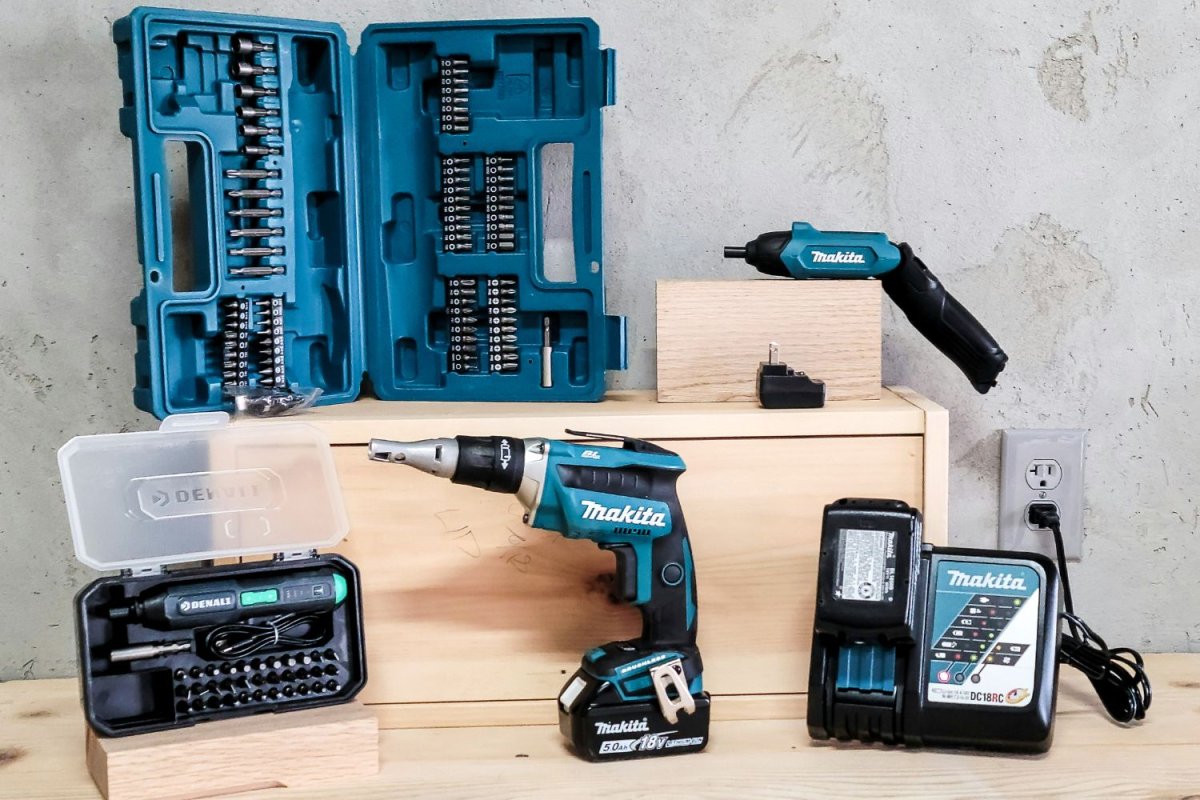
We may earn revenue from the products available on this page and participate in affiliate programs. Learn More ›

Whether you’re working on a bicycle, replacing kitchen outlets, putting batteries in a child’s toy, or completing a host of other DIY projects, a cordless screwdriver is a handy tool to tighten and remove screws quickly and efficiently. Think of a good cordless screwdriver as a less powerful alternative to a corded (or cordless) drill.
Cordless screwdrivers don’t have the power to drive through a lot of dense material, so don’t plan on building an entire storage shed with one. However, they can be a good option for light to medium jobs like running screws to hang pictures on walls, tightening cabinet door hinges, and removing outlet covers and switch plates. We’re big fans of power tools that make DIYers’ lives easier, and cordless screwdrivers rate right up there at the top.
With so many brands and types of cordless screwdrivers to choose from, it’s important to know which ones would be real assets in a DIYer’s tool collection and which ones didn’t live up to the hype. We tested several of today’s top-rated screwdrivers to determine their torque power, overall design, and how effectively they functioned in multiple situations. We put them through their paces, and we didn’t pull any punches—the testing was rigorous and we pushed the tools to their limits. We loved the DeWalt 8V MAX Gyroscopic Screwdriver Kit best for its 15-position clutch, gyroscopic trigger, and bright LED guide light.Don’t guess at how well today’s most popular power screwdrivers perform. If you’re in the market for the best cordless screwdriver, read on to learn which features are essential and find out why the following models earned a spot in our lineup.
- BEST OVERALL: DeWalt DCF680N2 8V MAX Gyroscopic Screwdriver Kit
↓ Jump to Review - RUNNER-UP: Milwaukee 2401-22 M12 ¼-Inch Hex Screwdriver Kit
↓ Jump to Review - BEST BANG FOR THE BUCK: Black+Decker BDCSFL20C 4V MAX Cordless Screwdriver
↓ Jump to Review - BEST FOR DRYWALL: Makita XSF03T 18V LXT Cordless Drywall Screwdriver
↓ Jump to Review - BEST HEAVY-DUTY: Bosch PS21-2A 12V MAX 2-Speed Pocket Driver Kit
↓ Jump to Review - BEST SAFETY FEATURES: Skil SD561201 4V Screwdriver With Circuit Sensor
↓ Jump to Review - BEST FOR ASSEMBLY: DeWalt DCF682N1 8V MAX Gyroscopic Inline Screwdriver
↓ Jump to Review - BEST FOR HOUSEHOLD USE: Makita DF001DW 3.6V Lithium-Ion Cordless Screwdriver
↓ Jump to Review - ALSO CONSIDER: Amazon Basics by Skil 4V Cordless Stick Screwdriver
↓ Jump to Review
| Testing Stats | |
|---|---|
| Products tested | 9 |
| Time spent testing | 12 hours |
| Tests performed | 6 |
| Price range | $25 to $276 |
Our Top Picks
To qualify for a spot in our lineup, a cordless screwdriver had to be simple to operate, durable, and have enough torque power to complete everyday fastener tasks. Whether built-in or removable, the batteries had to hold a charge long enough to get simple jobs done. We tested each tool on drywall and on two wood species, pine and birch. While cordless screwdrivers are not generally made for inserting screws into wood, some of today’s beefier models have souped-up power, and we tested them to see which could take on the task.
After extensive hands-on testing, the following models earned a spot on our list of the best cordless screwdrivers for a home or a workshop. They’re lightweight and compact enough to store in a drawer, carry in a tool belt, and tote to a worksite. Any one of these tools would be an asset in a DIYer’s tool assemblage.
Best Overall
DeWalt DCF680N2 8V MAX Gyroscopic Screwdriver Kit
Product Specs
- Grip type: Converts between pistol and barrel grip
- Battery power: 8 volts (removable)
- Speed: Up to 430 revolutions per minute (RPM)
What We Like
- Adjustable clutch settings reduce risk of stripping out screw heads
- Bright LED guide light
- Gyroscopic; user activates trigger by rotating the tool
What We Don’t Like
- On the pricey side
If the need is for a cordless screwdriver with plenty of features and a rock-solid reputation, the 8V MAX cordless battery screwdriver from DeWalt is a terrific choice. Like other cordless DeWalt tools, the 8V MAX cordless screwdriver comes with a removable battery (two batteries are included). We started by charging the battery overnight to ensure it was at full power for testing. Subsequent charging revealed it took just over an hour for the battery to reach a full charge.
The 8V MAX performed well on all our tests. It has a gyroscopic trigger that activates the motor with the motion of a wrist: Twist the tool to the right, it will tighten or drive a screw; twist left, and it will loosen the screw. A two-position handle allows a choice between a pistol grip and a straight barrel screwdriver, and two LEDs to light up a workpiece—a helpful plus.
To keep from stripping out screws, this DeWalt has a 15-position clutch, which we adjusted to suit the density of the boards. It features a speed range of up to 430 RPM, and a torque range of up to 40 inch-pounds. The ¼-inch chuck fits standard bits, and the lithium-ion battery can be used in other DeWalt 8-volt cordless tools.
What our tester says: “The 8V MAX cordless screwdriver aced all our tests, including quickly driving screws into drywall, pine, and even denser birch wood without bogging down.”—Glenda Taylor, Product Reviews tester & writer
Get the DeWalt DCF680N2 cordless screwdriver at Amazon, or Acme Tools.
Runner-Up
Milwaukee 2401-22 M12 ¼-Inch Hex Screwdriver Kit
Product Specs
- Grip type: Pistol
- Battery power: 12 volts (removable battery)
- Speed: Up to 500 RPM
What We Like
- High torque power
- Inserts screws into denser hardwood with ease
- Adjustable clutch
- Cancel-clutch feature reduces risk of stripping out screw heads
- Bright LED guide light
What We Don’t Like
- Feels slightly on the heavy side at over 2 pounds
Right out of the box, the first thing we noticed about the Milwaukee M12 was its weight. At more than 2 pounds (with battery installed), it’s heavier than many cordless screwdrivers, but it fits nicely in the palm and isn’t too cumbersome for installing multiple screws. It made quick work of inserting screws in drywall, and we were able to insert screws in both pine and birch boards as well.
The M12 is less about fancy features and more about getting the job done. This pistol-grip screwdriver uses Milwaukee’s 12-volt lithium-ion batteries to create a mighty peak torque of 175 inch-pounds. It has an RPM range of up to 500, which makes setting fasteners quick work. The 2401-22 model uses a ¼-inch quick-change keyless chuck to swap out bits quickly, and it has a 15-position clutch to help regulate torque. We were also able to switch into drill mode to cancel the clutch feature.
What our tester says: “This cordless screwdriver’s battery charges in under 30 minutes with the included charger, so we were able to get back to work after a short break.”—Glenda Taylor, Product Reviews tester & writer
Get the Milwaukee cordless screwdriver at Ace Hardware, The Home Depot, or Blain’s Farm and Fleet.
Best Bang For The Buck
Black+Decker BDCSFL20C 4V MAX Cordless Screwdriver
Product Specs
- Grip type: Converts from pistol to straight barrel grip
- Battery power: 4 volts
- Speed: Up to 180 RPM
What We Like
- Charges quickly; reaches full charge in about an hour
- Grip converts from pistol to straight barrel
- Very bright LED flashlight; can be used by itself or for low-light assistance
What We Don’t Like
- Not enough torque power to insert screws in hardwood
If the goal is to find a light-duty cordless power screwdriver that won’t crush screws or a budget, the Black+Decker 4V MAX cordless screwdriver may fill the bill. We were impressed by its versatile features and even more impressed by its budget-friendly price. While this tool doesn’t generate as much torque as some of the picks in our lineup, it still quickly inserted drywall screws. It wasn’t as successful with wood, but that’s not what this tool is intended to do.
This screwdriver has a three-position handle, swapping easily from a straight screwdriver to a 45-degree or right-angle driver in seconds. It uses ¼-inch driver bits, so users can swap between bits or employ the chuck as a ¼-inch nut driver. The screwdriver boasts an LED flashlight that was unusually bright, making it easy to see in darkened areas. The 4-volt screwdriver comes with two bits and a charger. Its 4-volt lithium-ion battery held a charge well throughout the testing, and this model features a built-in battery and a simple charger cord that plugs in directly.
Get the Black + Decker cordless screwdriver at Amazon, Lowe’s, or The Home Depot.
Best for Drywall
Makita XSF03T 18V LXT Cordless Drywall Screwdriver
Product Specs
- Grip type: Pistol grip
- Battery power: 18-volt rechargeable lithium-ion (brand specific)
- Speed: Up to 4,000 RPM
What We Like
- Adjustable screw depth to suit various thicknesses of drywall sheet
- Comes with a 5-amp-hour Makita 18-volt battery and a charger
- Creates a shallow dimple in drywall for taping
What We Don’t Like
- Not designed for use with other types of screws or materials
This battery-powered screwdriver from Makita does only one thing—inserts drywall screws into drywall—but it does it well. Unlike the other picks on this lineup, the XSF03T is a single-purpose tool.
We’ve installed hundreds of drywall sheets over the years, so we know that the screws used to attach the panels should create a dimple in the drywall but not tear its protective paper surface. The XSF03T is designed with a depth adjustment that made it easy for us to tweak the depth of the screw so we could achieve the dimpling effect on different thicknesses of drywall.
We charged the high-capacity 5-amp-hour battery that came with the tool and started testing. With just a few rotations of the depth-adjustment ring located on the nose of the tool, the Makita provided more or less torque to suit various drywall thicknesses. The trick to using this (and all) drywall screwdrivers is to physically push the tool as soon as the screw meets resistance from the wall stud. When done correctly (it takes some practice), the elongated nose on the Makita countersinks the screw head and creates a dimple in the drywall. The dimple will later be filled with compound when taping the walls.
The back end of the XSF03T is ergonomically designed for using a second hand to push with. This drywall screwdriver had ample power for inserting the screws without tearing the paper covering.
What our tester says: “We found it very comfortable to use, and we appreciated the bright LED guide light that made it easy to see where we were inserting screws in low-light situations.”—Glenda Taylor, Product Reviews tester & writer
Get the Makita XSF03T cordless screwdriver at Amazon, The Home Depot, or Acme Tools.
Best Heavy-Duty
Bosch PS21-2A 12V MAX 2-Speed Pocket Driver Kit
Product Specs
- Grip type: Pistol
- Battery power: 12-volt rechargeable
- Speed: Up to 1,300 RPM
What We Like
- Enough power and torque to easily insert screws into hardwood
- 2 speeds and a variable-speed trigger
- 21 clutch settings reduce risk of stripping out screw heads
What We Don’t Like
- Somewhat pricey compared to other screwdrivers tested
- LED light is not as bright as on comparable models
As soon as we slipped the charged 12-volt battery in the Bosch PS21-2A cordless screwdriver and pulled the trigger, we could tell it offered more torque than most. It has two speed ranges we could switch between by sliding a lever on the top of the tool. The screwdriver generates up to 1,300 RPM at top speed, which is quite an accomplishment for an automatic screwdriver.
It also packs some powerful torque—and we were able to insert screws with ease into drywall, pine, and birch boards. With that much torque, the 21-adjustment clutch is essential to prevent stripping out the screw heads.
In addition to ample torque and speed, this screwdriver is compact, with a head length of just more than 5.5 inches. It comes with two 12-volt batteries and a charger. Plus, there’s a built-in LED light to help users see in dim locations, but it would be better if it were brighter. If DIYers want a cordless screwdriver to tackle some heavy-duty jobs, the Bosch PS21-2A ought to do the trick. It’s a potent tool in such a small package, weighing in at only 1.4 pounds.
Get the Bosch cordless screwdriver at Amazon, Lowe’s, or Menards.
Best Safety Features
Skil SD561201 4V Screwdriver With Circuit Sensor
Product Specs
- Grip type: Straight barrel
- Battery power: 4 volts
- Speed: 230 RPM
What We Like
- Circuit sensor alerts user to the presence of a live wire
- Bright double LED lights
- Nonslip grip makes it easy to grasp and maneuver
What We Don’t Like
- Speed isn’t variable
- Not powerful enough to insert screws into wood (though quite capable with drywall)
Having previously believed the power to an outlet was shut off only to suffer painful shocks, we know the value of being able to test an outlet in a pinch. So we were pretty impressed with the Skil cordless screwdriver’s ability to sense if the outlet was still hot, just by depressing a button on the top of the tool. The Skil emitted a sharp warning beep when we tested a hot outlet, and a red light flashed. When we tested a dead outlet, there was neither a light nor a beep. This built-in safety feature is a boon for those who don’t typically carry electrical testers around while doing DIY projects. This compact cordless screwdriver boasts a dual-LED light, 10 changeable bits, and a micro USB charger. The chuck accepts any ¼-inch drive bit and also functions as a ¼-inch nut driver. It has both forward and reverse, but no adjustable clutch or speed settings. While it inserted screws effortlessly in drywall, it bogged down when trying to insert screws in wood boards. Still, it’s so valuable at sensing circuits that this cordless screwdriver could be reserved solely for electrical maintenance jobs.
Get the Skil 4V cordless screwdriver at Amazon, Menards, or Acme Tools.
Best for Assembly
DeWalt DCF682N1 8V MAX Gyroscopic Inline Screwdriver
Product Specs
- Grip type: Straight-barrel type
- Battery power: 8 volts
- Speed: Up to 430 RPM
What We Like
- Gyroscopic operation; regulate speed by rotating the tool
- Bright LED guide light
- Ergonomic nonslip grip
What We Don’t Like
- Slight learning curve with the gyroscopic operation
The DeWalt 8-volt MAX cordless screwdriver was the very first of the screwdrivers we tested, and we were not yet familiar with its gyroscopic technology. At first, it seemed counterintuitive, but now, it’s one of our favorite features.
Here’s how the gyroscopic effect works: Line up the tool with the screw that will be inserted or removed. Then squeeze the trigger, which will cause the tool to emit a hum. Next, either rotate the tool to the right or the left. When rotated to the right, the screw bit also turns to the right to insert a screw. When rotated to the left, the bit reverses and twists to the left to remove a screw. It’s that simple—no need to push buttons to change directions. We learned to increase or decrease the speed just by rotating the tool more or less.
The screwdriver’s chuck accepts ¼-inch bits and runs on a rechargeable 8-volt DeWalt battery (included). It generates up to 430 RPM and comes with a bright LED guide light. Its straight barrel-type grip makes it easy to reach corners where a pistol grip might be too cumbersome. The ability to control the screwing mechanism just by rotating the tool makes it well suited to assembling prefab bookcases, cabinets, and more.
Get the DeWalt inline cordless screwdriver at Amazon, or Lowe’s.
Best for Household Use
Makita DF001DW 3.6V Lithium-Ion Cordless Screwdriver
Product Specs
- Grip type: Converts from pistol to straight-barrel grip
- Battery power: 3.6 volts
- Speed: 220 RPM
What We Like
- Converts between pistol and barrel grip
- LED guide light can be turned off to preserve battery power
- Charges via USB cord
- Comes with an AC adapter and 81-piece accessory kit
What We Don’t Like
- Tool is designed for light-duty projects only
For all those little household fastener chores, such as installing outlet and switch plates, tightening cabinet or drawer screws, or hanging pictures on a wall, we think this lightweight Makita screwdriver is just the ticket. At just 3.6 volts, this little cordless screwdriver is designed for light-duty applications, and it excels in that capacity.
Rather than requiring the user to remove a battery, the DF001DW has an internal battery that charges via a USB cord that can be plugged into a computer’s USB port or a standard outlet using the included AC adapter. We tested the DF001DW by inserting and removing screws in drywall and wood. It comes with an ample 81-piece accessory set boasting bits for most types of screw fasteners used today, including Phillips, flat, and star bit. Plus, the tool has an LED guide light that can be turned on when desired (it doesn’t automatically stay on when the screwdriver is in use).
The DF001DW also converts from a pistol grip to a straight-barrel grip, making it even more versatile. It weighs less than a pound so it didn’t slow us down—yet it offered ample power for inserting and removing screws, even in wood, without the tool’s motor bogging down.
Get the Makita 3.6V cordless screwdriver at Amazon.
Also Consider
Amazon Basics by Skil 4V Cordless Stick Screwdriver
Product Specs
- Grip type: Straight-barrel grip
- Battery power: 4 volts
- Speed: Up to 300 RPM
What We Like
- Select from 1 of 3 torque settings
- No need to remove the battery; it charges via a USB-C cord
- Comes with 34-piece screw-bit kit and case
What We Don’t Like
- Light-duty only; motor bogged down slightly with dense hardwood
- LED light is pretty dim and unlikely to truly illuminate a work area
The Amazon Basics (formerly Denali) screwdriver doesn’t boast many bells and whistles, but it did allow us to choose from one of three torque settings. We found that handy when inserting screws into materials with different densities—for instance, more torque when inserting screws in wood than in softer drywall. It also features an LED guide light, but we found it to be dim and unlikely to offer much illumination in low-light situations.
The screwdriver charges via a USB-C cord (included). We liked this setup, as it simplifies charging—no need to remove and charge the battery separately. A compact tool measuring about 7 inches long, it was useful in restricted spots, but we would have liked a convertible grip. A barrel grip is excellent in some situations, but a convertible pistol grip would add versatility.
The only real downside we noted was that this model tended to bog down a little when we inserted screws in wood. It did the job, but it took longer than it did on drywall. Still, this is a handy little cordless screwdriver to have around the house or to keep in the trunk of a car for when small jobs arise.
Get the Amazon Basics cordless screwdriver at Amazon.
Jump to Our Top Picks
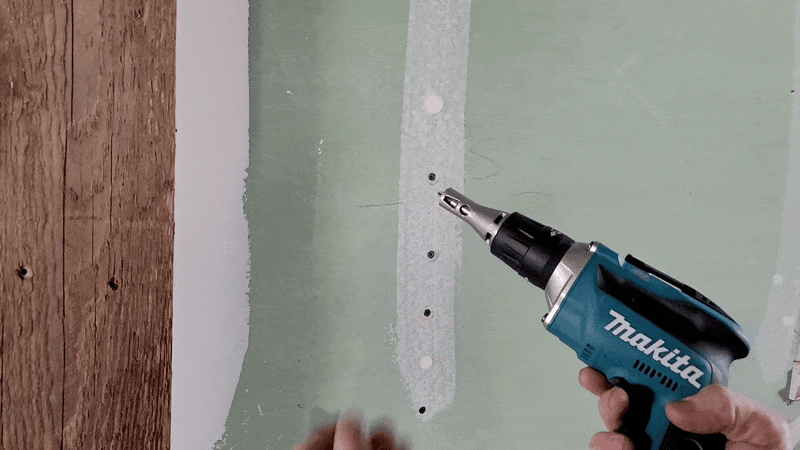
How We Tested the Best Cordless Screwdrivers
Consumers have come to expect a lot from national brands such as DeWalt, Milwaukee, and Bosch, but we wanted to expand our testing to cordless screwdrivers from a variety of manufacturers. All manufacturers list their tools’ strong points, but unless the products are personally tested, it’s difficult to know if they live up to the claims.
We tested every available function on each tool, including screw holders and light guides, and we scored each one using a rubric. While not every cordless screwdriver came with a souped-up 8- or 12-volt battery, we certainly appreciated the added torque. Each tool was also rated on the brightness of its guide lights, how the tool fit and felt in the hand, and whether it was truly user-friendly. DIYers have different needs and budgets, and any one of the picks in our lineup would be an asset to a tool collection.
What to Consider When Choosing a Cordless Screwdriver
While drills can be a bit unwieldy, a slim cordless screwdriver can fit into tight spots. And because it works faster than its manual predecessor, a cordless screwdriver will help keep a project on track. It can also reduce fatigue and benefit anyone with wrist or hand mobility issues—after all, twisting a wrist back and forth with a conventional screwdriver can become a real pain.
With a manual screwdriver, your hand can get in the line of vision, making it challenging to see what you’re doing and potentially causing the screwdriver to slip off fasteners. This isn’t a problem with a cordless model. Plus, because it’s lightweight and doesn’t require an outlet to plug into, it’s perfectly portable. A cordless screwdriver is a handy compact tool that can be toted anywhere. Keep these and the following considerations in mind while shopping so you’ll be better able to choose the model that best fits your needs.
Speed and Torque
The more power a cordless screwdriver has, the faster it can turn. While cordless screwdrivers don’t require the amount of power that a drill driver or an impact driver might have, they still need enough juice to get the job done. If purchasing a straight barrel-type driver, consider one with a speed between 300 and 500 RPM—ideal to loosen or tighten a screw quickly without being too fast to handle. With pistol grip models, speeds of more than 1,000 RPM are easier to control.
The more torque your screwdriver has, the denser the material that it can drive a fastener into. Heavy-duty screwdrivers have an increased amount of torque available and may be suitable for driving a few drywall screws into wood studs, but this can drain the battery quickly.
Maneuverability
A cordless screwdriver can reach and manipulate screws in small, awkward spaces much more easily than a manual tool can. If there is room for the tip of the driver to go onto the fastener, these powered screwdrivers help do the rest.
To fit into such tight places, the best cordless screwdriver is highly maneuverable. A slim, compact design helps, and many models also have rotating handles that swap from a straight grip to a pistol grip, like those seen on drills and screw guns. Also, a smaller battery size makes cordless screwdrivers easier to tuck between boards and other low-clearance scenarios, such as behind sinks for plumbing tasks.
Power Source
Many cordless screwdrivers come with rechargeable batteries, and they tend to range between 4 and 8 volts. Since a cordless screwdriver requires much less speed and power than a drill, these lower voltages are adequate. The benefit of a smaller lower-voltage battery is that it fits in smaller places than full-size options, and it helps make the rechargeable screwdriver as light as possible.
Some lower-end screwdrivers use replaceable batteries. These models are less convenient, not to mention expensive, if replacing batteries frequently. They usually have less power and torque as well.
Battery Life
If there is a large project coming up, it’s helpful if a cordless screwdriver has enough power to see it through to the end. Luckily, battery life isn’t much of a concern for most of the best cordless screwdrivers because their small motors don’t use as much battery energy as a large motor does.
However, some cordless screwdrivers have a battery level indicator that alerts users when it’s running low on power. It’s helpful to know the battery status so it can be juiced up while on a lunch or supply-run break, as many typically recharge in about an hour.
Screw Type
Cordless screwdrivers tighten or loosen screws in prethreaded holes. They’re perfect for screws in electrical boxes and fixtures, screws used in automotive interiors and appliances, installing door locks and cabinet hardware, and other mechanical settings with threaded holes.
Except for the most heavy-duty electrical screwdrivers, these tools are not typically designed for lag screws and bolts, wood screws, and fasteners in other dense materials. While it’s possible to drive a screw through drywall with one of these tools, that’s simply not the type of job these tools are made to tackle. For this situation, grab a drill or an impact driver instead.
Chuck Size
Cordless screwdrivers use toolless chucks, so swapping between bits is quick and easy. These chucks fit ¼-inch bits—the same bits used in standard multi-bit manual screwdrivers. There are also ¼-inch-drive drill bits, allowing a screwdriver to be used as a drill in light-duty material like thin wood or plastics.
The variety of ¼-inch bits available make cordless screwdrivers incredibly useful. Alternate from driving Phillips head screws to removing Allen or Torx screws in seconds. Most cordless screwdrivers use magnets to hold the bits in place while also providing a bit of magnetism to keep the screw on the end of the bit.
Clutch
The clutch in fastening tools regulates the amount of torque applied to a fastener. Once the set torque is reached, the clutch will start to “slip,” preventing the tool from driving the fastener or drilling any deeper. Just adjust the clutch according to the type of fastener and the type of material. Since this is situation specific, the rule of thumb is to set the clutch to a low setting and increase slowly as needed.
Too much torque can break smaller, older, or low-quality fasteners. Fortunately, the best cordless screwdrivers have adjustable clutch settings to avoid stripping or breaking these fasteners. The clutch can also avoid overdriving the screw too deeply, which may also cause unwanted results.
Torque settings can make a significant difference when working with old, stubborn fasteners. Instead of tearing the heads off screws or stripping the fastener beyond recognition, the clutch will begin to slip, preventing the driver from continuing to turn and causing damage.
Not all cordless screwdrivers have adjustable clutches, though. Some don’t have the power to require one. However, higher-end screwdrivers with more torque usually do.
The Advantages of Owning a Cordless Screwdriver
By the time a project with a lot of assembly is finished, your forearm and hand might be tired from using a manual screwdriver. Lesson learned: To forgo hand and arm fatigue, pick up a cordless screwdriver, which may also save energy and time, allowing you to move on to the next project.
Being able to see what you’re doing is key to a quality finished project. If your hand keeps getting in the way of a task, the tool may slip off the screw, marring the surface or scratching the workpiece. Cordless screwdrivers let users see what they’re doing since a hand won’t block the view.
Instead of carrying several screwdrivers around in a tool box or tool belt, it can be easier to tote just one cordless model. Since the bits are easy to swap, a complete bit set can reduce the overall weight and free up space in a belt for other tools. It’s much easier to carry one cordless screwdriver with eight tips than eight separate screwdrivers.
- Cordless screwdrivers minimize user fatigue when driving several fasteners.
- Smaller cordless screwdrivers allow you to see a workpiece better.
- One screwdriver can take the place of a drawer-full of manual screwdrivers, making for easier portability to the jobsite.
Tips for Using the Best Cordless Screwdriver
A cordless screwdriver is a tool that many reach for again and again for a host of different tasks. Here are a few ways to get the most help from this handy tool.
- Drill pilot holes for driving screws into dense materials. If using a cordless screwdriver to drive a screw into wood, drill a pilot hole first. Most of these tools simply don’t have the power or torque to run a fastener into dense materials.
- A drop of soap on the threads may help drive a screw into dense material. If driving a new screw without a pilot hole, try a bit of lubrication like a drop of liquid hand or dish soap on the threads. This may provide enough lubrication to allow a cordless screwdriver to get the job done.
- Use the ¼-inch chuck to loosen or tighten ¼-inch hex screws. Many small hex-head screws on appliances like washers, dryers, and refrigerators are ¼ inch. That means the tip of a cordless screwdriver will fit over the head, and it can tighten or loosen these screws.

The Advantages of Owning a Cordless Screwdriver
By the time a project with a lot of assembly is finished, your forearm and hand might be tired from using a manual screwdriver. Lesson learned: To forgo hand and arm fatigue, pick up a cordless screwdriver, which may also save energy and time, allowing you to move on to the next project.
Being able to see what you’re doing is key to a quality finished project. If your hand keeps getting in the way of a task, the tool may slip off the screw, marring the surface or scratching the workpiece. Cordless screwdrivers let users see what they’re doing since a hand won’t block the view. Instead of carrying several screwdrivers around in a tool box or tool belt, it can be easier to tote just one cordless model. Since the bits are easy to swap, a complete bit set can reduce the overall weight and free up space in a belt for other tools. It’s much easier to carry one cordless screwdriver with eight tips than eight separate screwdrivers.
- Cordless screwdrivers minimize user fatigue when driving several fasteners.
- Smaller cordless screwdrivers allow you to see a workpiece better.
- One screwdriver can take the place of a drawer-full of manual screwdrivers, making for easier portability to the jobsite.
Tips for Using the Best Cordless Screwdriver
A cordless screwdriver is a tool that many reach for again and again for a host of different tasks. Here are a few ways to get the most help from this handy tool.
- Drill pilot holes for driving screws into dense materials. If using a cordless screwdriver to drive a screw into wood, drill a pilot hole first. Most of these tools simply don’t have the power or torque to run a fastener into dense materials.
- A drop of soap on the threads may help drive a screw into dense material. If driving a new screw without a pilot hole, try a bit of lubrication like a drop of liquid hand or dish soap on the threads. This may provide enough lubrication to allow a cordless screwdriver to get the job done.
- Use the ¼-inch chuck to loosen or tighten ¼-inch hex screws. Many small hex-head screws on appliances like washers, dryers, and refrigerators are ¼ inch. That means the tip of a cordless screwdriver will fit over the head, and it can tighten or loosen these screws.
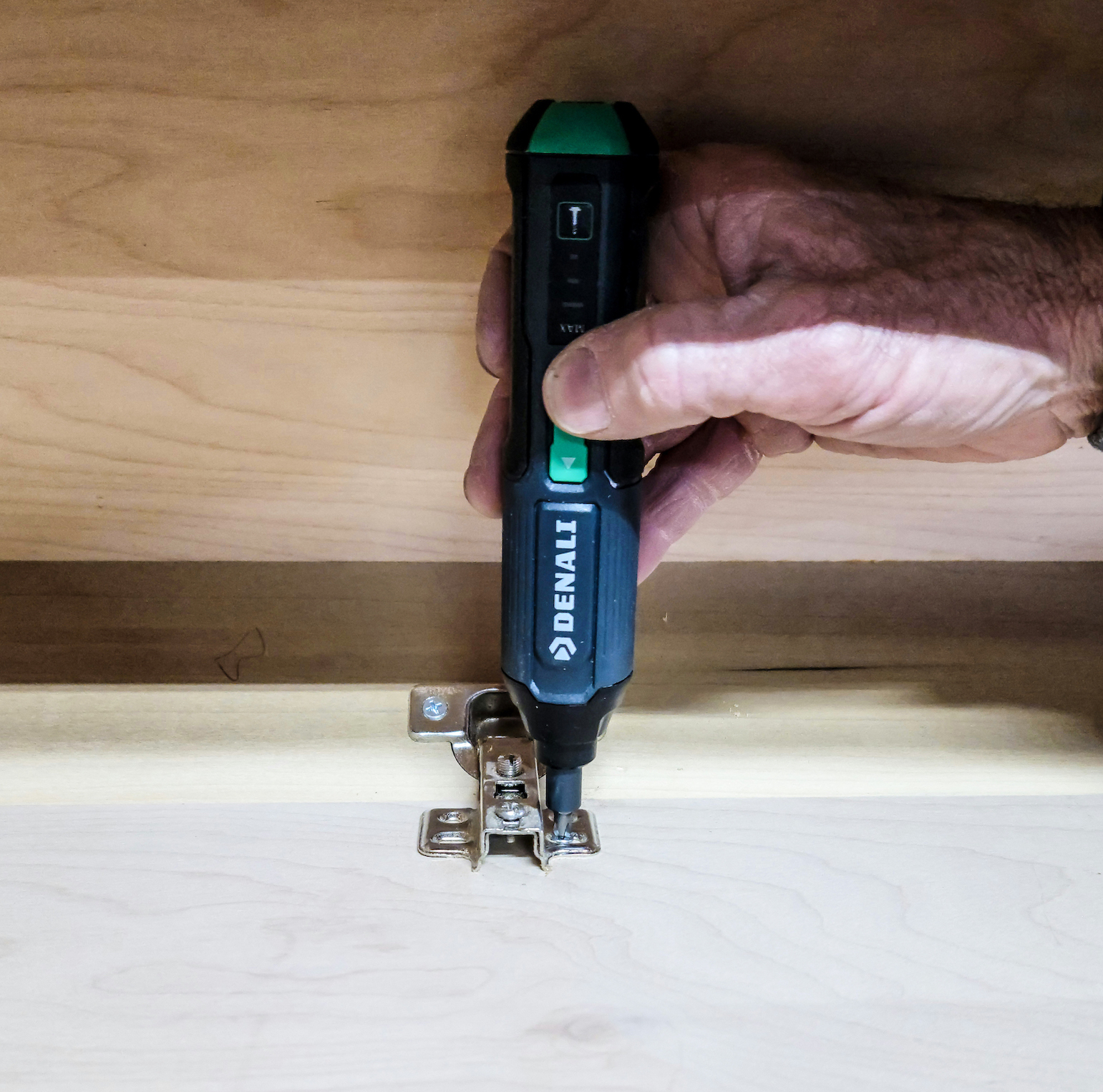
FAQs
There’s a lot to consider when selecting a new cordless screwdriver, so there may be some lingering questions. If you’re still wondering about the ins and outs of cordless screwdrivers, check out these answers to some commonly asked questions.
A cordless screwdriver is a battery-operated tool that tightens and loosens screws with a motor and a trigger instead of using the user’s hand power.
Cordless drills for DIYers accept several drill bit sizes with adjustable chucks, while cordless screwdrivers only accept ¼-inch bits. Also, cordless drills tend to have more adjustability in terms of speed to allow drilling into different materials accurately and efficiently.
There are a few slightly different methods to operating a cordless screwdriver, but here is a general usage guideline:
1.Choose the right bit and place it in the chuck.
2. Adjust the direction you want to drive the screw (tighten or loosen) with the switch on the screwdriver.
3. Seat the bit completely into the head of the screw.
4. Maintain pressure on the fastener and squeeze the trigger.
Cordless tools with higher voltages are certainly more powerful, but that power comes at a cost. They weigh more and are less compact than lower-voltage options. For cordless screwdrivers, 4 to 8 volts is usually sufficient, especially for light-duty tasks.
It depends on how often you’ll use them and the tasks you most frequently perform. They can save quite a bit of time and effort and can increase your efficiency, all at a typically affordable price.
Why Trust Bob Vila
Bob Vila has been America’s Handyman since 1979. As the host of beloved and groundbreaking TV series including “This Old House” and “Bob Vila’s Home Again,” he popularized and became synonymous with “do-it-yourself” home improvement.
Over the course of his decades-long career, Bob Vila has helped millions of people build, renovate, repair, and live better each day—a tradition that continues today with expert yet accessible home advice. The Bob Vila team distills need-to-know information into project tutorials, maintenance guides, tool 101s, and more. These home and garden experts then thoroughly research, vet, and recommend products that support homeowners, renters, DIYers, and professionals in their to-do lists.
Meet the Tester
Glenda Taylor is a product tester and writer specializing in construction, remodeling, and real estate. She and her husband own a general contracting company, and she is experienced in both residential and commercial building applications. She tests a wide range of power tools as well as other home improvement, household, and lawn-and-garden products.
Additional research provided by Tom Scalisi.
